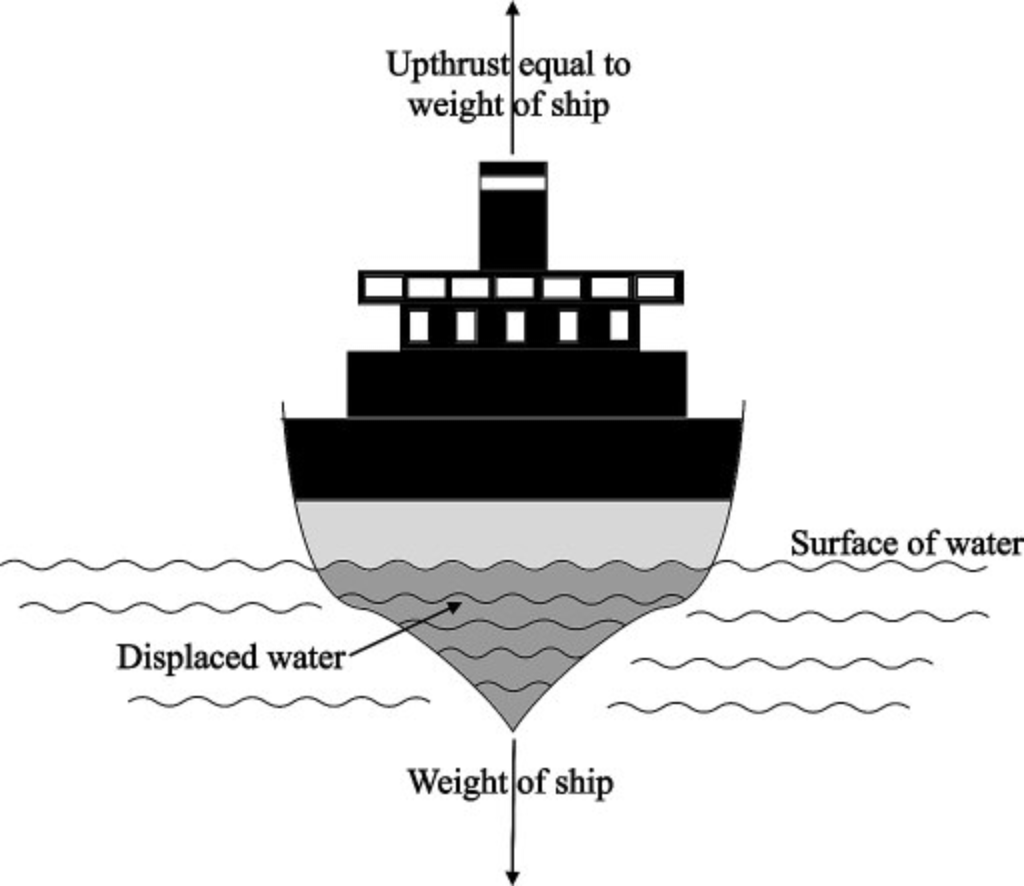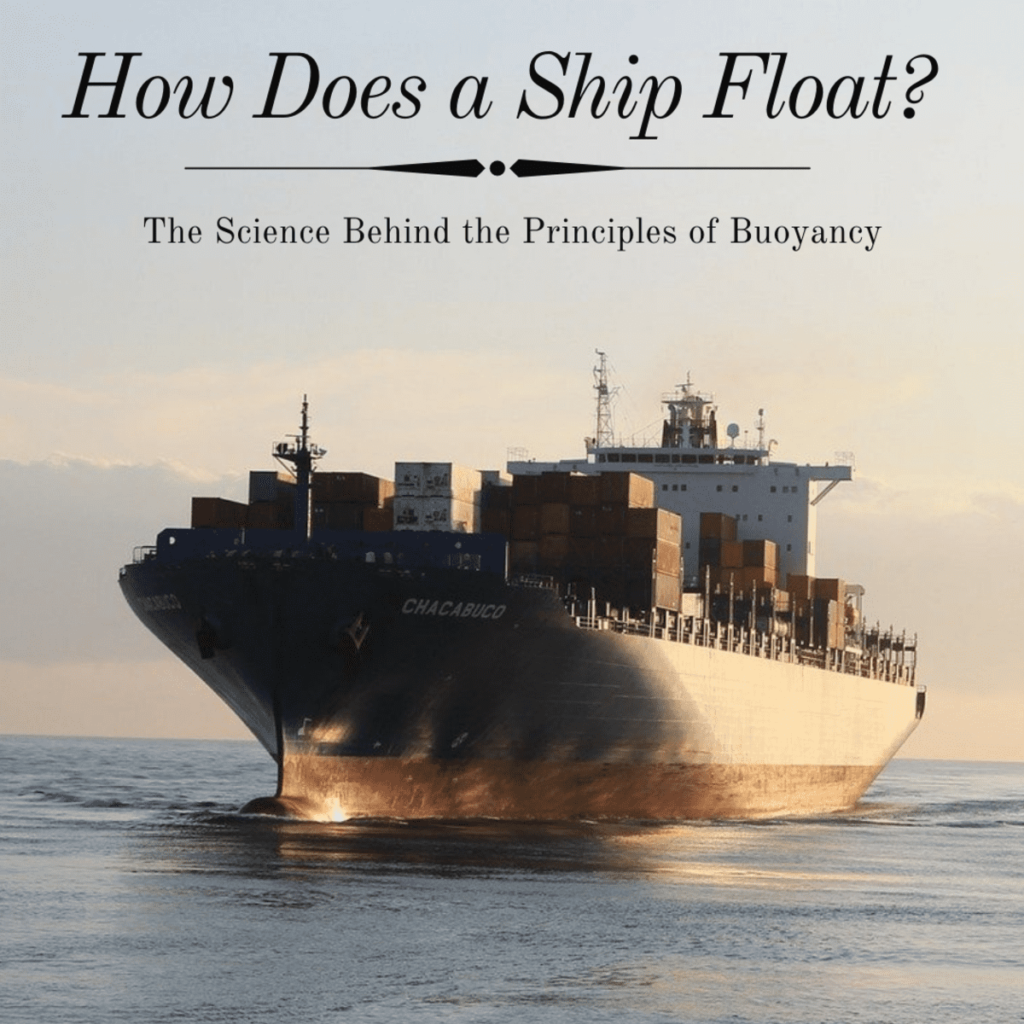Imagine yourself standing on the deck of a magnificent cruise ship, marveling at its massive size and grandeur. Have you ever wondered how a structure this colossal can defy the laws of physics and elegantly glide through the water? In this article, we will unveil the secrets behind the fascinating phenomenon of how ships float. Prepare to be fascinated as we delve into the intricacies of buoyancy and discover the science that allows these majestic vessels to effortlessly stay afloat.

The Basic Principle of Buoyancy
The Concept of Buoyancy
Have you ever wondered how ships, including large cruise ships, are able to float in water? Well, it all comes down to the fascinating concept of buoyancy. Buoyancy is the upward force exerted by a fluid that enables objects to float. In the case of ships, this fluid is water. When a ship is placed in water, the water exerts an upward force on the ship that counteracts the downward force of gravity. This balance between the upward buoyant force and the downward force of gravity allows the ship to stay afloat.
Archimedes’ Principle
The principle of buoyancy is best explained by Archimedes’ Principle, formulated by the ancient Greek mathematician Archimedes. According to this principle, the buoyant force acting on an object in a fluid is equal to the weight of the fluid displaced by the object. In simpler terms, when a ship enters the water, it displaces an amount of water equal to its own weight. This displaced water pushes back on the ship with a force equal to its weight, creating the upward buoyant force that enables the ship to float.
Understanding the Structure of Ships
Hull Design and Shape
The structure of a ship plays a crucial role in its ability to float. Ships are typically designed with a hull that is shaped in a way that allows for optimal buoyancy. The hull is the watertight body of the ship that forms its main structural component. Its shape is carefully designed to minimize the resistance of water and maximize buoyancy.
Different types of ships have different hull designs, depending on their intended purpose. For example, cruise ships often have a sleek, streamlined hull shape to reduce drag and increase efficiency. This design allows them to navigate through the water with ease while maintaining buoyancy.
Water Displacement
In addition to hull design, water displacement is another important factor in ship floatation. As mentioned earlier, when a ship is placed in water, it displaces an amount of water equal to its own weight. This displacement of water creates the buoyant force that keeps the ship afloat. The more water a ship displaces, the greater the buoyant force acting on it, and the higher it will float in the water.
The shape and size of a ship’s hull contribute to its water displacement. Ships with larger hulls and deeper drafts displace more water, allowing them to support greater loads and carry heavier cargo while still remaining buoyant.
The Role of Gravity
Weight of the Ship
While buoyancy provides the upward force that allows ships to float, the force of gravity cannot be overlooked. Every object, including ships, has weight, which is the force exerted on it by gravity. The weight of a ship is determined by its mass and the gravitational pull of the Earth.
To ensure that a ship stays afloat, its buoyant force must be equal to or greater than its weight. If the weight of the ship exceeds the buoyant force, the ship will sink. Therefore, ship designers must carefully consider the weight distribution of the ship to achieve optimal floatation.
Center of Gravity
Another factor related to ship floatation is the concept of the center of gravity. The center of gravity is the point at which the entire weight of a ship appears to be concentrated. For a ship to be stable and balanced, its center of gravity must align with its center of buoyancy.
Ship designers take into account the placement and distribution of weight within the ship to ensure that the center of gravity remains within a safe range. If the center of gravity is too high or too low, it can negatively affect the ship’s stability and potentially lead to capsizing.
Factors Affecting a Ship’s Floatation
Density of the Materials Used
The materials used to construct a ship can significantly impact its floatation. The density of the materials determines how much weight is distributed across a given volume. Ships are typically constructed using materials with lower densities, such as steel and aluminum, which allow for greater buoyancy. These materials are chosen for their strength, durability, and ability to withstand the harsh marine environment.
Load and Cargo Capacity
The amount of load and cargo a ship carries can also affect its floatation. The more weight a ship carries, the greater the downward force of gravity. To ensure that the ship remains buoyant, the buoyant force provided by the displaced water must be able to counterbalance the weight of the ship and its cargo.
When determining the cargo capacity of a ship, designers must carefully consider the ship’s buoyancy and stability characteristics. They factor in the ship’s size, shape, and distribution of weight to ensure that it can safely carry the intended load without compromising its floatation.

The Importance of Ballast
Stability and Balance
To maintain stability and balance, ships often make use of ballast. Ballast refers to the additional weight that is strategically placed within a ship to adjust its buoyancy and stability. By adding or removing ballast, ship operators can control the ship’s draft and thus its ability to float properly.
Ballast is particularly important for ships that frequently load and unload cargo, as it helps compensate for changes in weight distribution. By adjusting the ballast, operators can ensure that the ship maintains its desired stability and balance, even when its cargo load changes.
Ballast Tanks and Systems
Ballast is typically stored in ballast tanks within the ship’s hull. These tanks are watertight compartments that can be filled with water or emptied to adjust the ship’s buoyancy. By filling certain tanks, the ship’s draft and displacement increase, causing it to float higher in the water. Conversely, emptying these tanks reduces the ship’s draft and displacement, causing it to sit lower in the water.
Modern ships often use sophisticated ballast systems that can adjust the distribution of ballast throughout the ship to optimize stability. These systems allow for greater flexibility in managing the ship’s floatation characteristics, improving its overall safety and performance.
Ensuring Watertight Compartments
Bulkheads and Inboard Structures
Watertight compartments play a vital role in ship floatation and safety. Bulkheads, which are sturdy walls or partitions, are used to divide the ship’s interior into separate compartments. These bulkheads are constructed to be watertight, preventing water from flowing freely throughout the ship in the event of a leak or damage.
By having multiple watertight compartments, ships are designed to remain afloat even if one or more compartments become flooded. This ensures that the ship will maintain its buoyancy and stability, minimizing the risk of sinking.
Leaks and Damage Control
Despite the precautions taken, it is still possible for ships to develop leaks or sustain damage. In such situations, effective damage control systems and procedures are crucial in maintaining the ship’s floatation. Ship crews are trained to respond quickly and efficiently to potential leaks or damage, taking steps to seal off affected areas and prevent further flooding.
Regular inspections and maintenance are also performed to identify and repair any weak points in the ship’s structure. By constantly monitoring and addressing potential issues, ship operators can ensure that their vessels remain watertight and capable of maintaining proper floatation.

The Power of Displacement
The Effect of Displacement
Displacement is an essential concept in ship floatation. It refers to the volume of water that is displaced by a ship when it is fully immersed. The displacement of water creates the buoyant force that supports the ship’s weight and allows it to float.
The weight of the ship and its cargo directly determines the amount of water displaced. When the ship is loaded, more water is displaced, resulting in a higher buoyant force. Conversely, when the ship is empty or carries less cargo, it displaces less water, leading to a lower buoyant force.
Determining Ship’s Load Capacity
The ability to accurately determine a ship’s load capacity is vital for safe and efficient operations. Ship designers and naval architects use complex calculations and modeling techniques to determine the maximum load a ship can carry while still maintaining proper floatation and stability.
Factors such as the ship’s dimensions, hull design, displacement, and buoyancy characteristics are taken into account to establish the safe load capacity. By adhering to these calculations, ship operators can ensure that their vessels are not overloaded and can operate within established safety limits.
Ship Stability and Safety
Righting Moment
Ship stability is a critical consideration for ensuring safe and comfortable operations. The righting moment is a measure of a ship’s ability to return to an upright position after being tilted or heeled. It is the moment created by the force of buoyancy acting at a distance from the center of gravity.
To ensure stability, ships are designed so that the righting moment is always positive, meaning that it functions to return the ship to an upright position when it is tilted. This stability prevents excessive rolling or capsizing, guaranteeing the safety of the ship and its occupants.
Freeboard and Draft
Two important terms related to ship floatation and stability are freeboard and draft. Freeboard refers to the vertical distance between the waterline and the upper deck of the ship. It helps determine how much of the ship remains above the waterline and serves as a safety margin against waves and rough seas.
Draft, on the other hand, is the vertical distance between the waterline and the deepest point of the ship’s hull. It indicates how much of the ship is submerged in water. The draft of a ship can vary depending on factors such as the amount of cargo loaded or the distribution of weight within the ship.
By carefully considering the freeboard and draft of a ship, designers can ensure that it has adequate stability and buoyancy to operate safely in various sea conditions.

Ship Floatation during Water Displacement
Archimedes’ Principle in Action
The concept of Archimedes’ Principle is actively at work whenever a ship is in the water. As mentioned earlier, the buoyant force on a ship is equal to the weight of the water displaced by the ship. This upward force counteracts the downward force of gravity, allowing the ship to float.
Throughout a ship’s journey, the amount of water displaced can vary as the ship encounters different conditions. If the ship enters an area with denser water, it will displace a greater volume of water, resulting in a higher buoyant force. Similarly, if the ship encounters less dense water, it will displace less water, leading to a lower buoyant force.
Waterline and Draft Changes
As a ship floats in the water, its waterline and draft can change depending on various factors. The waterline is the level at which the ship’s hull meets the surface of the water. It provides a visual representation of the ship’s displacement and buoyancy. If the ship is more heavily loaded, its waterline will be lower, indicating a deeper draft.
Changes in waterline and draft can affect a ship’s stability and maneuverability. Ship operators and crews must be aware of these changes and make necessary adjustments to ensure safe navigation. Proper understanding of the ship’s floatation characteristics allows for a better response to changing water conditions, promoting overall safety and efficiency.
Improvements in Ship Floatation
Advancements in Ship Design
Over the years, advancements in ship design have led to significant improvements in ship floatation. Naval architects and engineers constantly strive to develop innovative hull designs and construction techniques that maximize buoyancy, stability, and safety.
By utilizing advanced computer modeling and simulation tools, they can accurately predict a ship’s floatation characteristics and optimize its performance. These tools allow designers to create more efficient hull shapes, reduce drag, and improve overall floatation.
Technology and Computational Tools
Advancements in technology have also played a crucial role in improving ship floatation. Modern ships are equipped with advanced sensors and monitoring systems that provide valuable data regarding the ship’s buoyancy, stability, and structural integrity.
Computational tools, such as computational fluid dynamics (CFD), help simulate complex fluid behavior and accurately predict ship performance. These tools enable designers and operators to analyze and optimize various aspects of a ship’s floatation, ensuring that it meets safety standards and operates efficiently.
In conclusion, the floatation of ships, including cruises, is governed by the principles of buoyancy and gravity. The careful design of the ship’s hull, consideration of weight distribution, and the use of ballast and watertight compartments all contribute to maintaining proper floatation. Advances in ship design, together with technology and computational tools, continue to improve the understanding and optimization of ship floatation, ensuring the safety and efficiency of maritime transportation.

Hi, I’m Mike, the author of Ocean Bliss Journeys. Thank you for visiting 🙂

